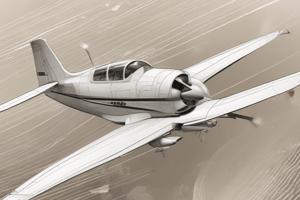Podcast
Questions and Answers
What is the measurement of latitude?
What is the measurement of latitude?
- Angular distance in degrees east or west of the Prime Meridian
- Angular distance in degrees north or south of the equator (correct)
- Angular distance in degrees above the horizon
- Angular distance in degrees around the Earth's circumference
What is the location of the North and South Pole in terms of latitude?
What is the location of the North and South Pole in terms of latitude?
- 180 degrees north and south latitude
- 0 degrees north and south latitude
- 90 degrees north and south latitude (correct)
- 45 degrees north and south latitude
What is the characteristic of latitude lines?
What is the characteristic of latitude lines?
- They converge at the poles
- They are perpendicular to each other
- They are numbered in a sequential order
- They are parallel to each other (correct)
What is the zero circle in longitude?
What is the zero circle in longitude?
What is the function of the International Date Line?
What is the function of the International Date Line?
Why do we use an angular distance instead of a straight distance to measure from a point of origin?
Why do we use an angular distance instead of a straight distance to measure from a point of origin?
What frequency does the marker beacon antenna operate on?
What frequency does the marker beacon antenna operate on?
What type of indicator shows lateral deviation and vertical deviation with respect to an aircraft symbol?
What type of indicator shows lateral deviation and vertical deviation with respect to an aircraft symbol?
What is indicated by the marker beacon indicator?
What is indicated by the marker beacon indicator?
Where is the marker beacon antenna usually fitted on the aircraft?
Where is the marker beacon antenna usually fitted on the aircraft?
What is displayed whenever the information supplying a function becomes unreliable?
What is displayed whenever the information supplying a function becomes unreliable?
What is the purpose of the Instrument Landing System (ILS) indicators?
What is the purpose of the Instrument Landing System (ILS) indicators?
What is the term used to describe the VOR presentation mode where the pilot can select a specific radial?
What is the term used to describe the VOR presentation mode where the pilot can select a specific radial?
What is the primary function of a Distance Measuring Equipment (DME)?
What is the primary function of a Distance Measuring Equipment (DME)?
What is the principle of operation of Distance Measuring Equipment (DME)?
What is the principle of operation of Distance Measuring Equipment (DME)?
What is the term used to describe the VOR presentation mode where the VOR information is displayed on a Horizontal Situation Indicator (HSI)?
What is the term used to describe the VOR presentation mode where the VOR information is displayed on a Horizontal Situation Indicator (HSI)?
What is the typical usage of Distance Measuring Equipment (DME) during flight operations?
What is the typical usage of Distance Measuring Equipment (DME) during flight operations?
What is a characteristic of a Distance Measuring Equipment (DME) ground station?
What is a characteristic of a Distance Measuring Equipment (DME) ground station?
What is the primary limitation of barometric altimeters?
What is the primary limitation of barometric altimeters?
What is the purpose of a worldwide information base in aviation?
What is the purpose of a worldwide information base in aviation?
How do radio altimeters measure the height of an aircraft?
How do radio altimeters measure the height of an aircraft?
What is the difference between pulsed systems and Frequency Modulated Continuous Wave systems?
What is the difference between pulsed systems and Frequency Modulated Continuous Wave systems?
Why is a barometric altimeter reading of 3000 feet relatively worthless in a mountainous area?
Why is a barometric altimeter reading of 3000 feet relatively worthless in a mountainous area?
How often is the worldwide information base updated by maintenance personnel?
How often is the worldwide information base updated by maintenance personnel?
What is the typical color code for the outer marker in an Instrument Landing System?
What is the typical color code for the outer marker in an Instrument Landing System?
What is the purpose of the VOR/LOC converter in an ILS receiver?
What is the purpose of the VOR/LOC converter in an ILS receiver?
How many satellites are used in the Navstar Global Positioning System?
How many satellites are used in the Navstar Global Positioning System?
What is the altitude of the GPS satellites above the Earth's surface?
What is the altitude of the GPS satellites above the Earth's surface?
What is the primary purpose of the original development of the GPS system?
What is the primary purpose of the original development of the GPS system?
What is the indication of the horizontal bar on the ILS indicator?
What is the indication of the horizontal bar on the ILS indicator?
Flashcards are hidden until you start studying
Study Notes
VOR System
- VOR (VHF Omnidirectional Range) can operate in two display modes: automatic and manual.
- Automatic mode presents VOR information on the Horizontal Situation Indicator (HSI).
- In manual VOR, pilots select specific radials for navigation.
Distance Measuring Equipment (DME)
- DME measures slant range from ground-based stations, important for landing and takeoff.
- The device works by timing the response of the UHF signal sent to the station; longer delays indicate greater distance.
- DME ground stations can manage multiple aircraft signals simultaneously.
Marker Beacon Antenna
- Operates at 75 MHz, typically located on the underside of the aircraft.
- Used for identifying marker beacons during flight.
Instrument Landing System (ILS) Indicators
- ILS information can be shown on HSIs, Attitude Director Indicators (ADIs), EADI/EHSIs, and Head-up Guidance Systems (HGSs).
- These indicators convey localizer (lateral) and glideslope (vertical) deviations, with warning flags for unreliable data.
Electronic Attitude Director Indicator (EADI)
- An advanced form of indicator displaying critical flight data, integrated into modern cockpit designs.
Marker Beacon Indicators
- Feature three color-coded lights indicating the type of marker beacon—outer (blue), middle (amber), and inner (white).
Altimeter Systems
- Barometric altimeters measure altitude based on local air static pressure, but can mislead in mountainous regions.
- Radio altimeters use radio waves to determine height above terrain, offering more accurate readings.
Navigation Principles
- Latitude measures angular distance north or south of the equator, with poles at 90°.
- Longitude is based on the Prime Meridian at Greenwich, with lines measured east and west; the International Date Line (IDL) marks the shift of calendar days.
Plotting Positions on Earth
- Positioning accounts for Earth's curvature, using angular measurements from a defined origin.
Instrument Landing System (ILS) Functionality
- Some ILS equipment integrates with VOR and communications receivers, providing localizer and glideslope deviation readings.
Global Positioning System (GPS)
- Initially developed by the U.S. Department of Defense, now utilized for civilian applications.
- Operates with a constellation of 24 satellites at approximately 20,200 km altitude, with 21 in active use and 3 as spares.
Studying That Suits You
Use AI to generate personalized quizzes and flashcards to suit your learning preferences.




